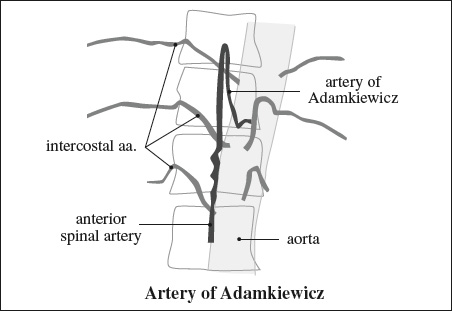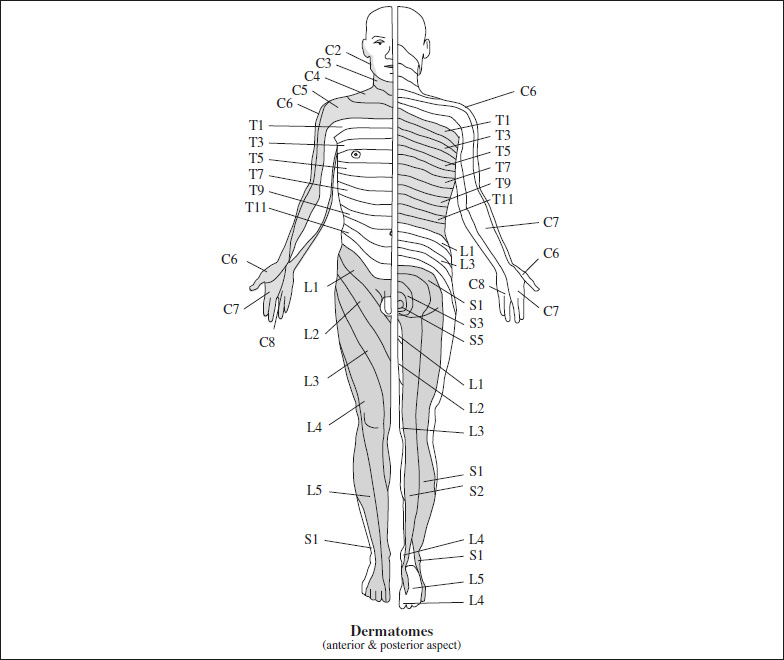= primary structural support of human body (Francis Denis, 1983)
- transmitting axial load of most of the body's weight
- restraining motion during flexion, extension, rotation, lateral bending
- Anterior column
= anterior longitudinal ligament, anterior annulus fibrosus, anterior ⅔ of vertebral body
Function: bearing axial load, resisting extension - Middle column
= posterior ⅓ of vertebral body, nucleus pulposus, posterior annulus fibrosus, posterior longitudinal ligament

Function: bearing some axial load, resisting flexion- Integrity of the middle column is synonymous with stability!
- Posterior column
= posterior elements (pedicles, facets, laminae) + ligaments (lig. flavum, interspinous ligament, supraspinous ligament)
Function: resisting flexion, stabilizing rotation + lateral bending
Posterior Ligamentous Complex (PLC)
Function: “tension band” of spinal column resisting compressive forces on vertebral bodies
- Supraspinous ligament
= strong cordlike ligament connecting tips of spinous processes from C7 to sacrum - Interspinous ligament
- Articular facet capsules
- Ligamentum flavum
= thick broad structure connecting laminae of adjacent vertebrae
Posterior Longitudinal Ligament
Function: contributes to stability of spinal column
Attachment: tethered to vertebral body via a central septum creating a left + right anterior epidural space
- superficial dorsal layer: 8–10 mm wide at disk space level separable from dura at dissection
- deep layer: 2–3 mm wide at disk space level
- 12 load-bearing vertebrae
- posterior arch (= pedicles, laminae, facets, transverse processes) handles tensional forces
- vertebral bodies:
- height of vertebrae anteriorly 2–3 mm less than posteriorly → mild kyphotic curvature
- AP diameter: gradual increase from T1 to T12
- transverse diameter: gradual increase from T3 to T12
Functional unit: 2 vertebrae + interconnecting soft tissues
- anterior portion = 2 aligned vertebral bodies + intervertebral disk + anterior and posterior longitudinal ligaments
- posterior portion = vertebral arches + facet joints + posterior ligamentous complex
= vertebra retaining partial features of segments below and above; total number of vertebrae in 92% unchanged with 24 (= 7 + 12 + 5) segments
Incidence: 3–21% of population
- Bertolotti syndrome = back pain from transitional 5th lumbar vertebra resulting in partial sacralization
- incidental finding
Location: thoracolumbar (4%) + lumbosacral (15%) junction
Variability of distribution (see table):
- variation from 12 thoracic + 5 lumbar segments maintaining together 17 presacral segments, eg, 11 thoracic + 6 lumbar OR 13 thoracic + 4 lumbar
- anomalous number of vertebrae (= 23 / 25 presacral segments)
- thoracolumbar / lumbosacral transitional vertebra
Thoracolumbar Transitional Vertebra
- one side with a rib (= laterally downsloping osseous structure with articulation to vertebra)
- other side with a transverse process (= horizontal osseous structure without central articulation to vertebra)
Lumbosacral Transitional Vertebra
- The first non–rib-bearing vertebra = L1
- “sacralized L5” = L5 incorporated into sacrum
- “lumbarized S1” = S1 incorporated into lumbar spine
- uni- / bilateral dysplastic / enlarged transverse processes of lumbosacral transitional vertebra ± uni- / bilateral contact / pseudarthrosis / fusion to adjacent sacral ala
- “squared” morphology of transitional vertebra
- decreased height of intervertebral lumbosacral disk
- none / small residual / well-formed S1-2 disk
- alteration of lumbosacral intervertebral disk angle
Cx: confusion over labeling / assignment of vertebral levels during treatment planning
- Counting cephalad from presumed lumbosacral angle can lead to errors!
Numbering Vertebral Levels at Lumbar MR
Nota bene:
- The iliolumbar ligament (= low SI structure extending from transverse process to posteromedial iliac crest) identifies the lumbosacral junction (99%), but does NOT ALWAYS denote level of L5
- The magnitude of the lumbosacral intervertebral disk angle is not useful
- A thoracolumbar transitional vertebra is NOT associated with an anomalous number of presacral segments
Distribution of Presacral Segments
Segments thoracic + lumbar seg. 23 5% 3.5% *11 + 5 1.5% *12 + 4 24 92% 89.0% *12 + 5 2.2% *13 + 4 0.8% *11 + 6 25 3% 2.4% *12 + 6 0.6% *13 + 5 * The cervical spine is morphologically stable with 7 vertebrae
- A lumbosacral transitional vertebra is associated with an anomalous number of presacral segments:
- Avoid wrong-level spine surgery and obtain whole-spine localizer image!
MR Report:
- “This report assumes that there are five lumbar-type vertebrae, with the lowest lumbar vertebra identified by the iliolumbar ligament.”
- “A lumbosacral transitional vertebra is present characterized by …. The lowest well-formed intervertebral disk is at ….”